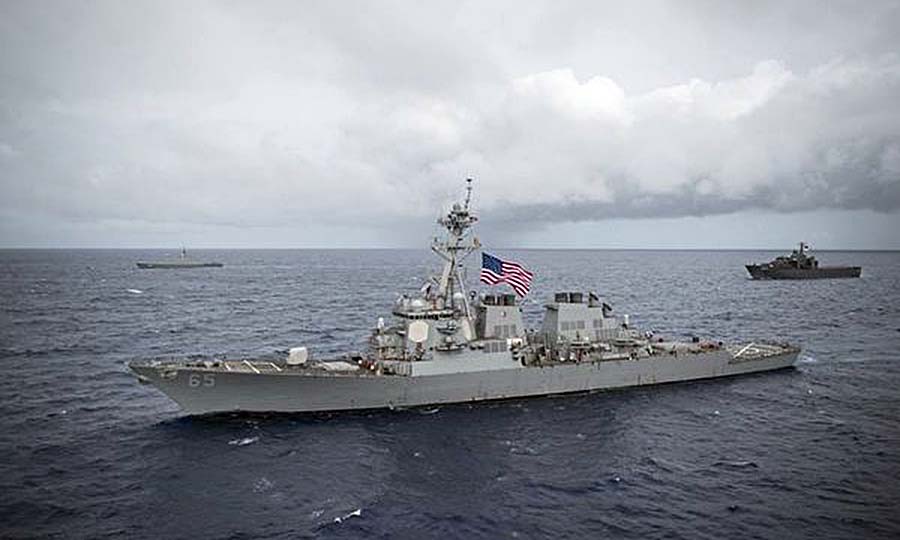Global Courant 2023-05-03 09:10:21
The decision by US President Harry Truman on June 25, 1950, to deploy the Seventh Fleet to the Taiwan Strait to prevent the Chinese Communists from landing on the island was, without a doubt, a flagrant intervention in China’s internal affairs.
Despite the intervention of America, to the extent that two Chinese actors, namely the People’s Republic of China and the Republic of China, compete against each other, the Taiwan issue is still a Chinese domestic issue.
However, both the passage of time and geopolitical factors have contributed to the problem taking on an international dimension. Ultimately, then, Taiwan can be defined as an internal Chinese issue with international repercussions; these, in turn, could escalate into open confrontation between the United States and China.
That the outcome of such a confrontation would be catastrophic is a given, hence the impetus to try to work out a settlement that would be an improvement on the current situation, one that a number of other givens cannot ignore.
The two Chinas
First, the relationship between the two Chinas in terms of land size, population, economic influence and military potential is and will remain totally asymmetrical.
Second, Taipei, in any guise, poses no threat to Beijing, politically or economically.
Third, promoting Taiwan does not “include” China, if only Taiwan is the largest outside investor in China. Thus, Taiwan’s prosperity actually contributes to the Chinese economy.
Fourth, the sine qua non of Taiwan’s existence under its present guise is its American umbrella.
Fifth, the presence on Chinese soil of two government powers is something Beijing can live with. What is not acceptable, however, is for a part of China, sponsored by a foreign power, to secede from the Chinese state. So for Beijing, a foreign-sponsored secession is a red line that cannot be crossed, and the reason why this is so is about much more than just politics.
National integrity
For a country that has been invaded, colonized and at one point reduced to a shadow of itself, the Taiwan issue is the latest chapter in a long story of foreign interference and humiliation.
So for Beijing, ‘reunification’ is much more than a political exercise. It relates to the realm of the emotional and to the restoration of full dignity to a nation deprived by foreign intervention of exercising its authority over part of its territory.
So when all is said and done, Beijing’s only non-negotiable requirement is the formal preservation of the integrity of its borders.
This in turn leads to another question: what are the chances that Beijing will come back to this question in the near future? While nothing is static in politics, all indicators are that this is a stance on which Beijing will not shift.
Balancing exercise
On paper, the current confrontation involves three parties: the People’s Republic of China, the authority that rules Taiwan, and the United States. In terms of the balance of power, however, it is about a conflict between Washington and Beijing.
When Washington deployed the Seventh Fleet in the Taiwan Strait in 1950, it had a degree of military superiority in the region that was unchecked. Today, that superiority is still real, but challenged.
Twenty years from now, if China continues on its current course, America’s military superiority could have turned into a balancing act at best. So time is not on the side of the United States.
At that point, if Beijing chose to act decisively against Taiwan, whether through a blockade, embargo, or, less likely, military intervention, the United States could find itself in a position to its power to keep its sphere of influence will outweigh its benefits.
As far as Beijing is concerned, decisive action against Taiwan could provoke a massive reaction that would not work in its favour.
The end result is that a negotiated solution is in the interests of the two main contenders, namely the United States and China.
However, launching such a process would require the one ingredient that is now missing from the confrontation, namely the political will to find a realistic alternative to the current deadlock.
Promoting that political will should now be a priority, both for Washington and for the other key players in the region, such as Japan and South Korea. But those who can give substance to that can only be the two Chinese actors, namely Beijing and Taipei.
Integration versus independence
Over the decades, the semblance of dialogue developed between Beijing and the Kuomintang (KMT) over Taiwan. Over time, this took the form of cross-strait talks leading to a number of technical agreements between the two sides, including air links and the like.
These talks took a step back in 2016 with the electoral defeat of the KMT and the rise of the People’s Democratic Party to power. While the KMT was essentially pan-Chinese, the DPP had “independence” in its program, and the result was a corresponding contraction of “cross-Strait” dialogue to a minimum.
With Beijing convinced that the DPP is actually pursuing secession and that Washington is underhandedly encouraging such an outcome, China has practically given up presenting a political option to the current deadlock. At the same time, a small faction in the central government would welcome Taiwan’s declaration of independence, as this would remove all restrictions on dealing with the breakaway province.
This approach is echoed by a minority in Taiwan and among the Taiwanese diaspora in the United States, who in effect encourage “independence” on the assumption that it would lead to a more active role for Washington in support of Taiwan.
The end result of this situation is that there are reasons to believe that the current status quo will not last indefinitely and that it is, in fact, slowly unraveling.
The alternative is a dialogue between the two Chinas on the assumption that what is at stake is not incompatible with two fundamental demands of the parties involved, namely that Taiwan continue to exercise its self-government and that Beijing ensures that it is exercised within the framework of a ‘Greater China’.
Within this perspective, Beijing has formulated a number of archetypes in recent decades; and while they were all rejected by the KMT and perhaps overtaken by time, they could form a general negotiating framework today.
Towards a workable formula
These would primarily include Taiwan becoming part of a larger China with its capital and central government in Beijing, albeit with the status of an autonomous entity. This, in turn, would require some amendment to both the Chinese Constitution and the Constitution of Taiwan.
Second, Taiwan would retain all of its administrative institutions and political system, including an independent military force. The central government would not second personnel to Taiwan, which would keep its own civil service. Foreign relations would herald the central government, but not foreign trade and investment.
Third, economic relations within China would be subject to agreements between both sides of the Strait, which would also cover population movements, residence permits, and the like.
How to shape dialogue is a moot point, but the “cross-strait” formula model is one option that has proven workable in the past.
There is no guarantee that a suitable solution will emerge from a dialogue between the Chinese parties. Conversely, it is a given that tensions in the current climate can only increase, with the potential to escalate into open confrontation with dire consequences at best.
So for Washington, encouraging the two Chinese sides to engage in meaningful dialogue should be a priority. And so is an unequivocal message to Taiwan that while the United States and its allies support the island in principle, it doesn’t mean they automatically agree with the firm rejection of any reasonable package Beijing has presented.
Last but not least, the people of Taiwan must have their say. Currently, neither secession nor integration into the system in place on the mainland seems to appeal to the majority of the island’s population. That leaves room for an alternative solution to the current impasse that would benefit everyone.
Similar:
Loading…








